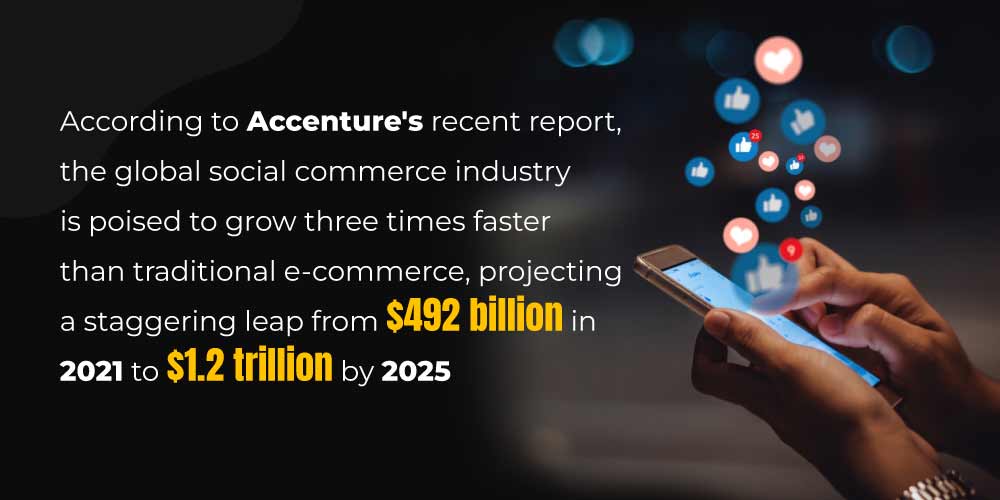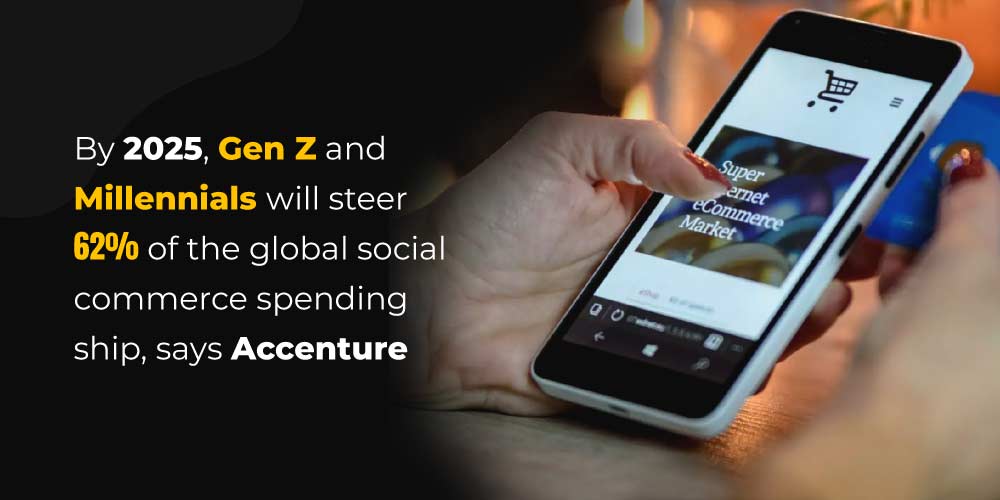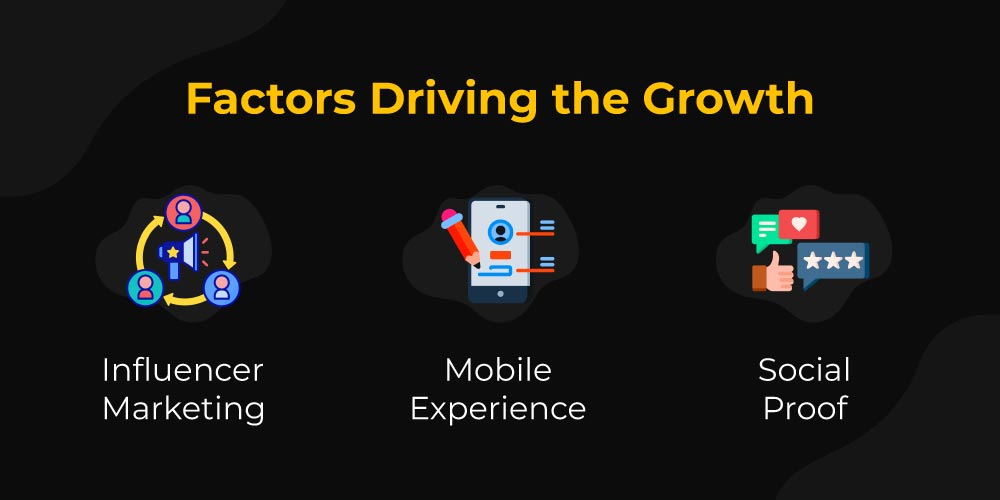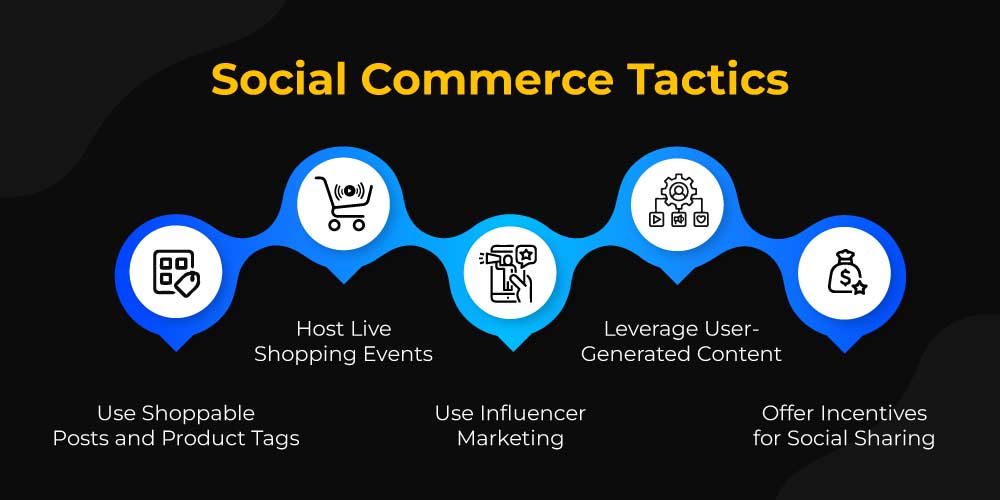Future of Shopping: Social Commerce Strategy Revolution
Introduction to Social Commerce
In the dynamic realm of e-commerce, a revolutionary trend is taking center stage – Social Commerce. It’s not just about transactions, it’s a social experience that blends online shopping with the power of social media. This blog explores the intricacies of Social Commerce Strategies and its transformative impact on the way we shop.
Defining Social Commerce
Social Commerce is an innovative approach that integrates social media and e-commerce, allowing users to discover, engage, and purchase products seamlessly within their preferred social platforms. It’s an evolution that turns social interactions into potential business transactions.
How Social Commerce Works
Unlike traditional e-commerce, Social Commerce leverages the interactive nature of social media. Businesses showcase their products on platforms like Instagram and Facebook, offering users the ability to make purchases without leaving the social environment.
Benefits for Businesses and Consumers
- Businesses: Direct access to a vast audience, turning social engagement into tangible sales.
- Consumers: A personalized and interactive shopping experience within the familiar environment of social networks.
Examples of Successful Social Commerce Initiatives
Leading brands, such as Nike and Kylie Cosmetics, have mastered the art of Social Commerce. Nike seamlessly integrates shopping features into its Instagram presence, while Kylie Cosmetics turns social media engagement into a thriving online marketplace.
The Rise of Social Commerce
In today’s digital landscape, where global internet users spend an average of 2 hours and 27 minutes daily on social media, the ascent of social commerce is undeniable. Brands are redirecting their marketing efforts to meet customers where they spend the majority of their online time, understanding that social platforms are now not just a place to connect but also to shop.
The Social Commerce Boom


According to Accenture’s recent report, the global social commerce industry is poised to grow three times faster than traditional e-commerce, projecting a staggering leap from $492 billion in 2021 to $1.2 trillion by 2025. But what exactly is social commerce?
In simple terms, it’s the fusion of e-commerce and social media, allowing users to discover, add to cart, and make purchases without leaving their favorite social apps. Facebook, Instagram, TikTok, and Pinterest are leading the charge, providing features that enable seamless transactions.
Rerouting the Path to Purchase
Unlike the traditional e-commerce journey, social commerce doesn’t redirect users to an external online store. Instead, it brings the store to the user, eliminating unnecessary steps and enabling direct checkouts within the social media platform. This simplicity encourages quick decisions and impulse buys, particularly well-suited for low-priced items. The Social Commerce Boom
According to Accenture’s recent report, the global social commerce industry is poised to grow three times faster than traditional e-commerce, projecting a staggering leap from $492 billion in 2021 to $1.2 trillion by 2025. But what exactly is social commerce?
In simple terms, it’s the fusion of e-commerce and social media, allowing users to discover, add to cart, and make purchases without leaving their favorite social apps. Facebook, Instagram, TikTok, and Pinterest are leading the charge, providing features that enable seamless transactions.
Driving Forces Behind Social Commerce Growth


The surge in social commerce aligns with the global increase in social media usage, and it’s largely propelled by Gen Z and millennial consumers. Predictions indicate that these demographics will contribute to 62% of global social commerce spending by 2025.
By 2025, Gen Z and Millennials will steer 62% of the global social commerce spending ship, says Accenture.
Accessories, apparel, cosmetics, home decor, and consumer goods currently dominate the revenue charts.
Live Commerce: A Fusion of Shopping and Entertainment
Live-streamed shopping events, often dubbed as “QVC for Gen Z,” present a novel way for brands to connect with their audience. By partnering with influencers and hosting interactive video sessions, brands can engage in real-time, answer questions, launch products, and facilitate in-the-moment purchases. China leads in this trend, exemplified by the remarkable success of live streamers who sold $3 billion worth of goods in a single day.
The Bigger Picture: Omnichannel Approach
While social commerce promises a dynamic future, a more valuable opportunity awaits those who adopt an omnichannel approach. Success in engaging and retaining social commerce customers hinges on understanding them and optimizing the customer journey across all channels. By delivering authentic experiences at every touchpoint, brands can build trust, loyalty, and affinity.


Factors Driving the Growth
The surge in Social Commerce is not a coincidence but a result of several key factors propelling its growth.
- Influencer Marketing: Collaborations with influencers provide brands with a powerful channel to showcase products authentically, reaching a wider audience.
- Mobile Experience: The seamless integration of Social Commerce with mobile technology ensures that users can shop conveniently on the go, contributing significantly to its popularity.
- Social Proof: The influence of peer recommendations and user-generated content builds trust, prompting users to make informed purchase decisions.
Impact of Social Media Platforms on Consumer Behavior
Social media platforms wield immense influence over consumer behavior, steering the course of Social Commerce.
- Targeted Content: The tailored content on platforms like Instagram and Facebook directs users toward products that align with their interests and preferences.
- Interactive Engagement: Social media encourages active engagement, allowing users to ask questions, provide feedback, and share their experiences, fostering a sense of community.
- Impulse Shopping: The visually rich and interactive nature of social platforms triggers impulse purchases, turning browsing into buying seamlessly.
The Role of Mobile Technology in Social Commerce
Mobile technology is the linchpin in the Social Commerce ecosystem, ensuring a smooth and convenient shopping experience.
- In-App Purchases: Mobile apps of social platforms enable users to make purchases without redirecting to external websites, streamlining the buying process.
- Push Notifications: Timely alerts about promotions, new products, or personalized recommendations keep users engaged and informed.
- User-Friendly Interfaces: Intuitive interfaces on mobile devices enhance the overall user experience, making Social Commerce accessible to a broader audience.
Creating a Social Commerce Strategy
Now that we understand the dynamics driving Social Commerce, let’s delve into crafting a robust strategy for businesses aiming to leverage this transformative trend.
Identify Your Target Audience and Their Social Media Habits
Understanding your audience is paramount in the world of Social Commerce.
- Conduct Surveys: Gather insights through surveys to understand your audience’s preferences, shopping behaviors, and preferred social platforms.
- Analyze Social Media Analytics: Use analytics tools to identify peak times of user activity and the type of content that resonates the most.
Choose the Right Social Media Platforms for Your Business
Not all social platforms are created equal, strategic selection is key.
- Demographic Alignment: Choose platforms aligned with your target audience’s demographics.
- Content Relevance: Select platforms where your product content is most relevant and likely to engage users.
Develop a Content Strategy That Is Relevant and Engaging
Content is the backbone of Social Commerce. A well-crafted strategy ensures consistent engagement.
- Visual Appeal: Invest in high-quality visuals that showcase your products effectively.
- Storytelling: Narrate compelling stories about your brand and products to create an emotional connection with your audience.
Use Social Media Advertising to Reach Your Target Audience
Paid advertising on social platforms amplifies your reach and drives targeted traffic.
- Ad Campaigns: Design targeted ad campaigns to reach specific demographics.
- Promotions: Utilize promotions and discounts to entice users and encourage conversions.
Integrate Social Commerce Into Your Website and E-commerce Platform
Seamless integration is crucial to creating a cohesive shopping experience.
- Unified Experience: Ensure a consistent look and feel between your social commerce presence and your website.
- One-Click Purchases: Simplify the checkout process to minimize friction and encourage quick purchases.
With a strategic foundation in place, businesses can now move on to deploying tactics to enhance their Social Commerce presence. In the next segment, we’ll explore specific tactics, including shoppable posts, live shopping events, influencer marketing, user-generated content, and incentivizing social sharing.


Social Commerce Tactics
Strategic implementation of tactics is the key to unlocking the full potential of Social Commerce. Let’s delve into the actionable steps that can elevate your brand’s presence in the world of Social Commerce.
Use Shoppable Posts and Product Tags
Shoppable posts are a game-changer in turning social engagement into sales.
- Streamlined Purchases: Enable users to make purchases directly through the social platform, minimizing the steps between product discovery and checkout.
- Product Tags: Tag products in your posts, providing users with instant information and a direct link to purchase.
Host Live Shopping Events
Live shopping events add an interactive and dynamic element to Social Commerce.
- Real-time Engagement: Engage directly with your audience in real-time, answering questions and showcasing products dynamically.
- Urgency and Exclusivity: Create a sense of urgency and exclusivity by offering limited-time promotions exclusively during live events.
Use Influencer Marketing
Leverage the power of influencers to extend your reach and build credibility.
- Reach a Wider Audience: Collaborate with influencers whose audience aligns with your target demographic.
- Authenticity: Influencers bring authenticity to your brand, fostering trust and enhancing your Social Commerce presence.
Leverage User-Generated Content
User-generated content (UGC) is a powerful tool in building trust and social proof.
- Customer Reviews: Encourage customers to share their experiences through reviews, photos, and videos.
- Showcasing Products in Real Life: UGC provides a real-world perspective on your products, making them more relatable.
Offer Incentives for Social Sharing
Incentivizing social sharing can turn your customers into brand advocates.
- Discounts and Rewards: Offer discounts or exclusive rewards for customers who share their purchases on social media.
- Contests and Challenges: Create challenges or contests that encourage users to share their experiences with your products.
Implementing these tactics will not only enhance your Social Commerce strategy but also contribute to increased brand visibility and engagement. In the upcoming segment, we’ll explore how to measure the success of your Social Commerce strategy using key metrics and analytics tools.
Measuring the Success of Your Social Commerce Strategy
Effective measurement is crucial for refining and optimizing your Social Commerce strategy. Let’s explore the key metrics and analytics tools that provide valuable insights.
Track Key Metrics
- Website Traffic:
- Monitor the volume and sources of traffic generated through your social commerce efforts.
- Social Media Engagement:
- Track likes, comments, shares, and overall engagement on your social media platforms.
- Sales Conversion Rates:
- Measure the percentage of visitors who make a purchase, providing insights into the effectiveness of your strategy.
Use Analytics Tools
- Google Analytics:
- Leverage Google Analytics to track user behavior on your website, including their journey from social platforms to conversion.
- Social Media Insights:
- Utilize built-in analytics tools on social media platforms to gain specific insights into your audience and post-performance.
- Conversion Attribution Models:
- Understand which touchpoints in your customer’s journey contribute most to conversions, helping allocate resources effectively.
Make Adjustments to Your Strategy as Needed
Regular adjustments are essential to keeping your strategy aligned with evolving trends and consumer behaviors.
- A/B Testing: Experiment with different elements of your strategy, such as post timing, content types, and ad formats, to identify what resonates best with your audience.
- Customer Feedback: Listen to customer feedback and reviews, making adjustments based on their experiences and preferences
The Future of Social Commerce
As we navigate the ever-evolving landscape of e-commerce, let’s gaze into the crystal ball and anticipate what the future holds for Social Commerce.
Emerging Trends in Social Commerce
- Social Commerce Integration:
- Expect deeper integration of Social Commerce features directly within social platforms, reducing friction in the purchasing process.
- AI-Driven Personalization:
- Artificial Intelligence will play a pivotal role in tailoring recommendations and creating highly personalized shopping experiences for users.
- Immersive Experiences:
- Social Commerce will embrace immersive technologies, providing users with virtual and augmented reality experiences to enhance product visualization.
Augmented Reality (AR) and Virtual Reality (VR) in Social Commerce Strategy
- AR for Product Try-Ons:
- Users will be able to virtually try on products before purchasing, revolutionizing the online shopping experience.
- VR Shopping Environments:
- Virtual reality will create interactive shopping environments, allowing users to explore products in a virtual store setting.
Predictions for the Future Impact on Businesses and Consumers
- Continued Evolution:
- Social Commerce will continue to evolve, becoming an integral part of everyday life and shaping the future of retail.
- Seamless Social Integration:
- Businesses that seamlessly integrate Social Commerce into their overall strategy will thrive, meeting the expectations of a digitally engaged audience.
- Enhanced Customer Experiences:
- Consumers will enjoy enhanced and personalized shopping experiences, fostering loyalty and brand advocacy.
Conclusion
The journey through the world of Social Commerce has been nothing short of transformative. By unlocking its full potential today, businesses can stay ahead in the digital game and connect with users in ways that transcend traditional retail. Ready to embark on your Social Commerce journey? Implement the strategies and tactics discussed in this blog to supercharge your website’s performance. The future of shopping is social, and your brand can be at the forefront of this revolution.







